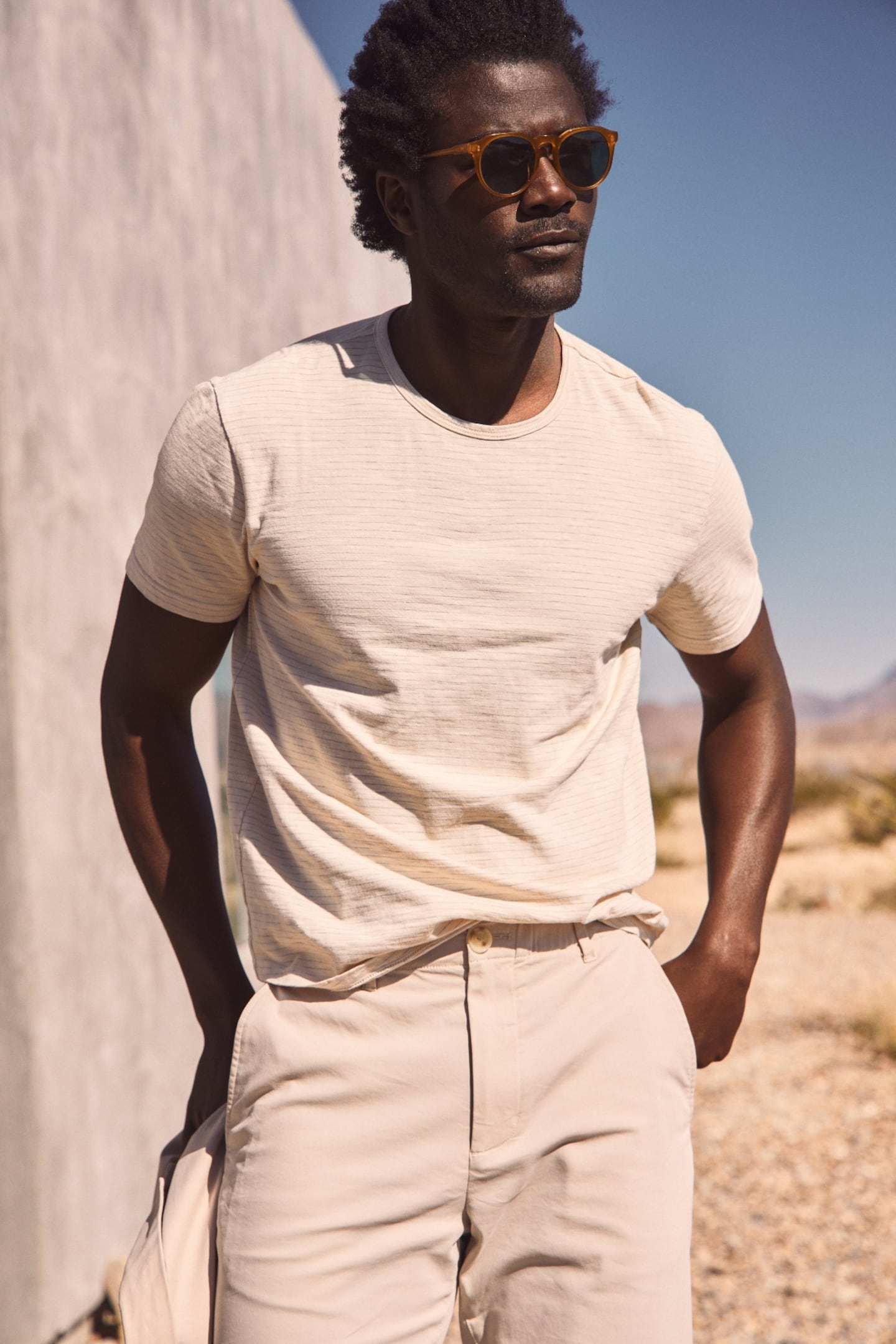
The Business of Fashion
Agenda-setting intelligence, analysis and advice for the global fashion community.

Agenda-setting intelligence, analysis and advice for the global fashion community.

After entrepreneur Mike Natenshon’s girlfriend threw out his favourite T-shirt, he founded a brand to create the perfect replacement.
Marine Layer launched in 2010 with one product: A multi-coloured striped T-shirt Natenshon hoped would evoke the feeling of Californian ease and comfort he got from his old favourite. More than a decade later, Marine Layer now sells a full range of goods like outerwear, sweaters and pants, but men’s T-shirts remain a major sales driver. In the past two months, the company has introduced two new T-shirts — a $54 tailored crewneck and a $48 lightweight tee in hemp cotton — and expects T-shirt sales to outpace the overall business’ year-over-year sales growth in 2024.
Marine Layer is just one of several DTC apparel labels that has built a profitable business on the premise of selling the perfect men’s T-shirt. Brands like Buck Mason and True Classic make tees that land somewhere between Hanes’ five-for-$22 T-shirt packs and $100 plus luxury tees from brands like James Perse. They’ve been able to turn a basic item shoppers can buy anywhere into a profit driver by constantly updating their fabrics and silhouettes to appeal to male shoppers who are wearing T-shirts more often and constantly scouring the internet for a version that aligns with their aesthetic sensibilities.
The amount of men’s T-shirts available in the market, which includes products from DTC, luxury and mass market brands, grew 42 percent in the last year, and weekly searches for the item were up 12 percent year-over-year this month, according to data firm Trendalytics. Because of that growth, brands that have invested in their men’s T-shirt offering see robust repeat purchase rates, a critical benefit at a time when it’s expensive and hard to find new shoppers. At Marine Layer, the retention rate for T-shirts is at least 10 percent higher than other categories, and the company generated more than $10 million in earnings before interest, taxes, depreciation and amortisation in 2023. The company’s sales grew 30 percent year-over-year to over $150 million. True Classic also saw 40 percent growth last year to $207 million in sales, and is seeking a $1 billion valuation.
ADVERTISEMENT
“E-commerce has actually driven the male shopping behaviour to be much stickier,” said Mo Zhou, a venture partner at investment firm Global Innovation Capital. “That’s caused a lot of male shoppers to be more loyal to their specific brands once they find them.”
These brands have also found a path to profitable growth at a time when many of their DTC peers are in crisis mode. Activewear brand Outdoor Voices shuttered all its retail stores last month and is reportedly planning to file for bankruptcy. Sneaker seller Allbirds’ sales dropped 15 percent in 2023, and its stock has traded at less than $1 for over a year; Nasdaq warned that if it can’t get its stock price up within six months, it will be delisted.
These brands’ success is not just about T-shirts, but rather rooted in an ability to build a community of ardent followers, invest in improving the quality of their tees and expand into categories that compliment their hero product.
“Anybody can get a T-shirt made quickly. That’s not hard,” said Anthony Choe, founder of investment firm Provenance, an investor in Marine Layer. “The hard part is doing something different that people care about and notice.”
Having a hero product that is as accessible and pervasive as a T-shirt means that brands have to pay attention to the details in order to stand out.
For Marine Layer that’s meant focussing on its multi-coloured stripes, while Buck Mason’s tees are known for their signature curved hem. To keep customers coming back, these brands regularly introduce new designs and experiment with fabrics.
In the last 18 months Marine Layer has ramped up its rollout of tees in new materials. Since its launch earlier this year, the new natural hemp cotton tee, meant to look soft and worn-in, has seen sales volumes comparable to Marine Layer’s bestselling $48 signature crew tees within that same period.
“We’re obsessed about the details of the T-shirt and really try to turn over the different use cases,” Natenshon said. “We’re always trying to find new functionality.”
ADVERTISEMENT
At Buck Mason, where T-shirt sales grow more than 40 percent year over year — higher than any of its other product categories — customer retention comes exclusively from updating the fabrics and colours of popular silhouettes like its original $45 Supima cotton tee. The 11-year-old brand used its profits to purchase a knitting mill in Mohnton, Pennsylvania in December 2022 to better control how quickly it can update and improve its materials. Buck Mason launched its “Toughknit tee” made from American-grown Supima cotton jersey last September, and it will launch a line of indigo-coloured tees in the coming months, said co-founder Sasha Koehn.
“If you haven’t spent a lot of time refining that [original] item, it’s not going to lead to increased sales,” said Yasunobu Kyogoku, founder of Innovation Global Capital, which has invested in Marine Layer, Buck Mason and shoe maker Rothy’s.
Brands in this sector can’t survive on just selling T-shirts alone. While men’s T-shirts are a high customer retention driver for Marine Layer, they currently only account for 18 percent of its overall men’s product assortment, according to data analytics firm Edited. The most successful start-ups have diversified their product offering to grow sales, finding that T-shirts are often a gateway to getting customers to buy items in other product categories.
“You may sell one T-shirt and if they love it, that’s great. They might buy another three. But if you don’t have more to offer, it doesn’t really matter,” said Innovation Global Capital’s Kyogoku.
Since its launch, True Classic has sold most of its tees in three, six and nine packs ranging from $60 to $130, which meant that some customers would go a full year before buying a new pack. In early 2023, the brand started gifting items from new categories, such as its $20 boxer briefs, for customers that spend more than $150 in a single transaction, to incentivise customers to buy more goods in those categories, said Ryan Bartlett, True Classic’s co-founder and chief executive.
When launching new goods, some brands ensure those items have a more direct link to their hero product.
Marine Layer, for example, uses fabrications that are similar to what it uses for its T-shirts for other categories. In February, the company launched its $178 Saturday Breeze blazer and corresponding $128 chinos, developed in a similar blend of cotton and spandex that’s found in its tailored crew neck tees. Those have helped boost sales of the tees and the blazer and chinos, which are often bought as a set. True Classic, meanwhile, plans to launch a women’s T-shirt line in the final quarter of the year; it expects womenswear to make up at least 40 percent of sales in the coming years.
“Once you have one product that the customer loves and is passionate about, then you have the approval of the customer to try and offer something else and the critical thing there is, it has to be the right thing,” Kyogoku said. “If you continue to exceed their expectations … customers are always happy.”
While the DTC landscape’s turbulence isn’t completely over for brands, the prospect of a better economy in 2024 is encouraging profitable brands that shied away from M&A last year to start preparing for an exit.
True Classic has emerged from a sea of men’s brands promising the perfect t-shirt, managing to build a big audience without bleeding cash.
With the direct-to-consumer funding heyday now over, DTC brands need to turn a profit. Unlike their revenue-obsessed counterparts, DTC pioneers Marine Layer, Meundies and Trinny London offer a blueprint for achieving both top- and bottom-line growth.

Malique Morris is Direct-to-Consumer Correspondent at The Business of Fashion. He is based in New York and covers digital-native brands and shifts in the online shopping industry.
In London, where independent labels have been hit hard by the implosion of key stockist Matches, brands like Clio Peppiatt, Marfa Stance and Completedworks have grown direct-to-consumer businesses that peers can learn from.
Apparel brands Knot Standard and Billy Reid are teaming up in a move investors say we may see more of as fashion start-ups seek alternative funding routes to grow their businesses.
Warby Parker, Everlane and other brands are partnering with small, but buzzy fashion labels as an inexpensive way to find new customers, and regain some status with shoppers who have moved on.
The embattled athleisure brand has mounting cash problems, Sourcing Journal says.